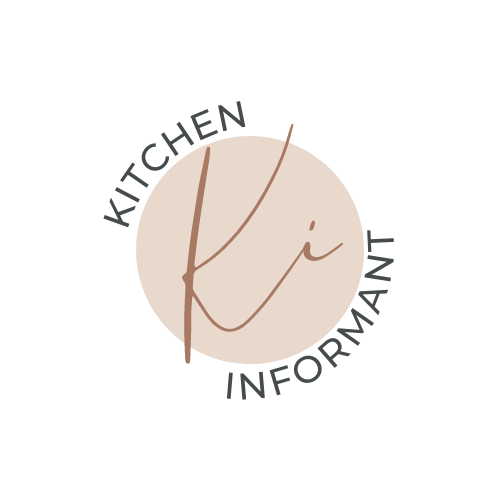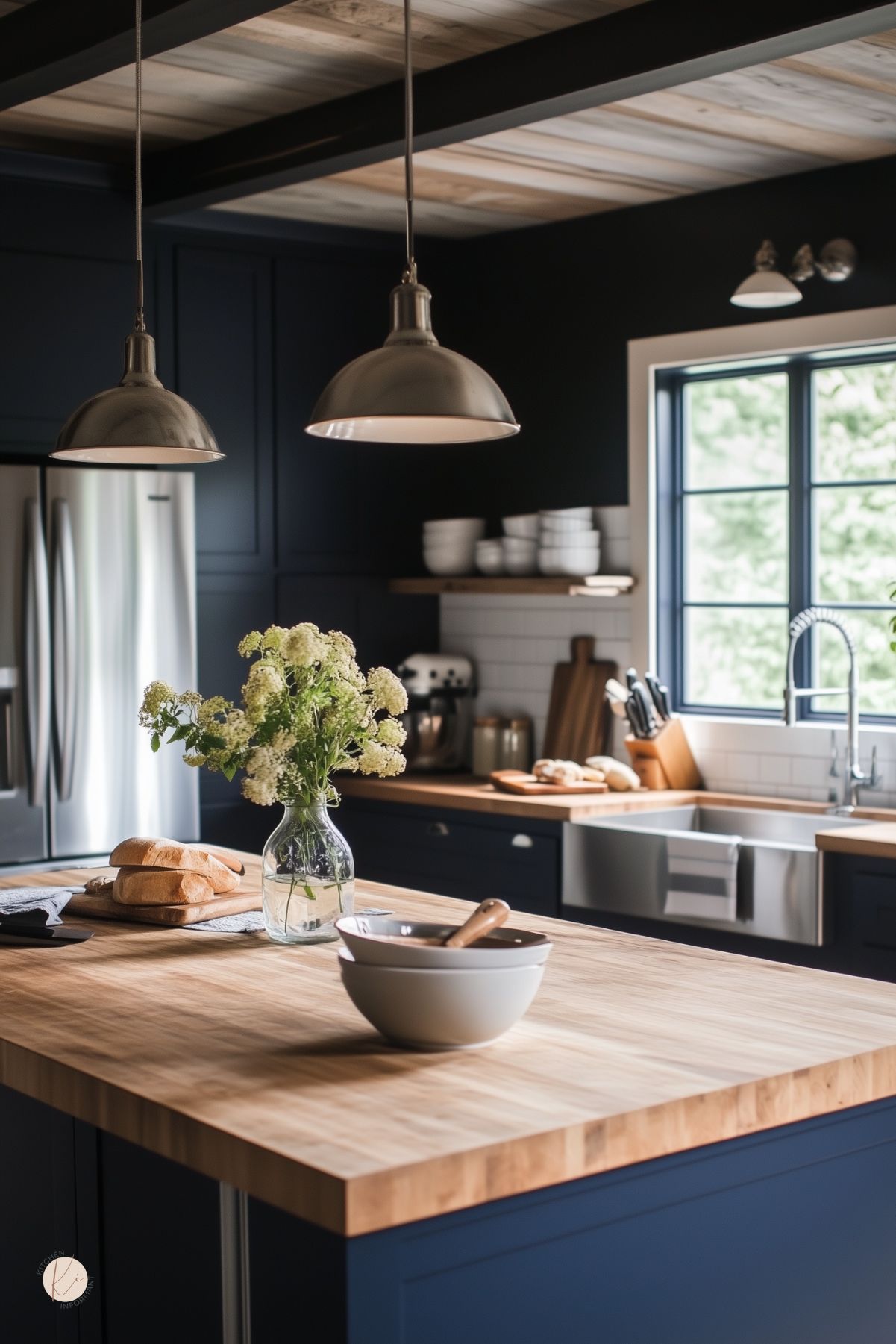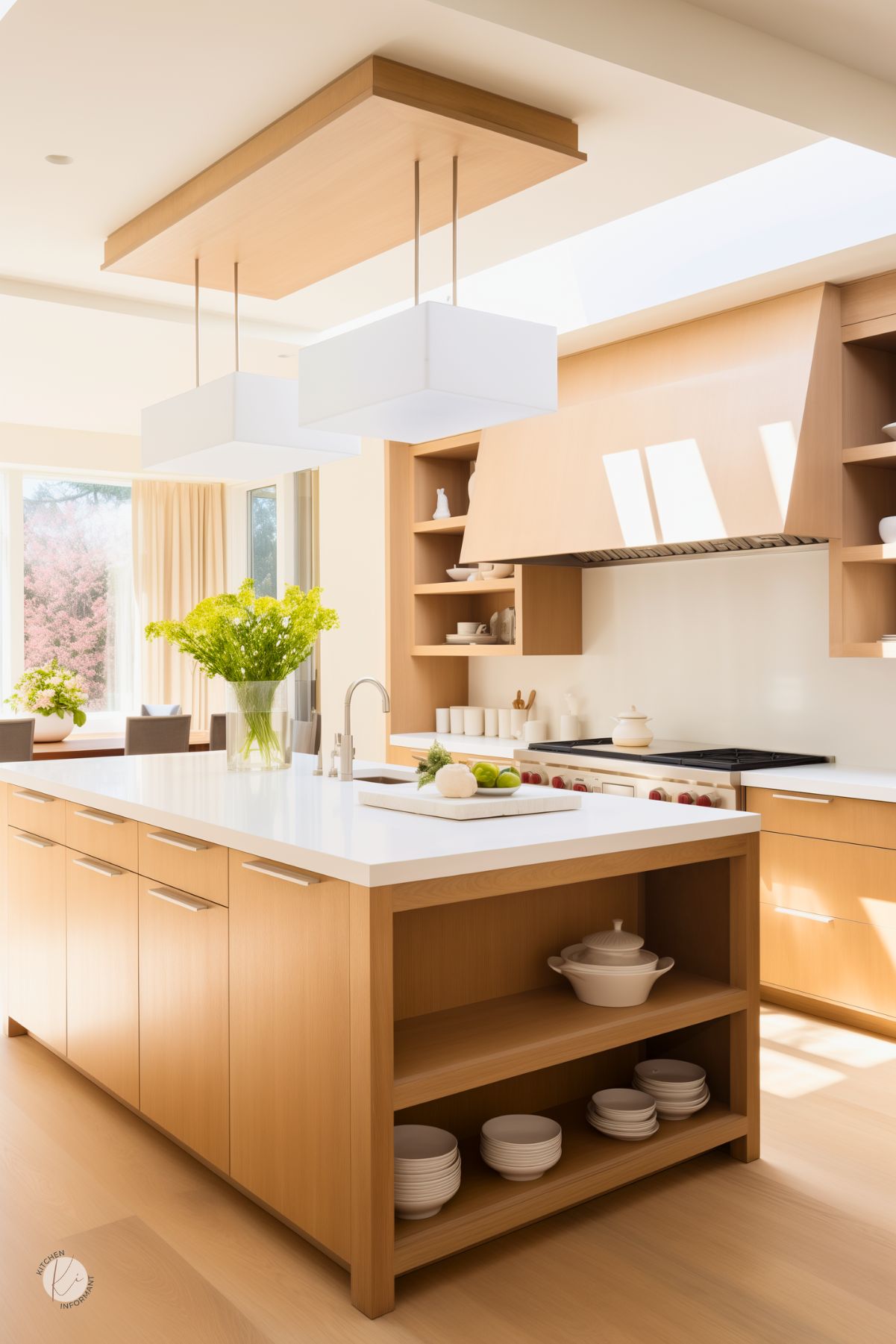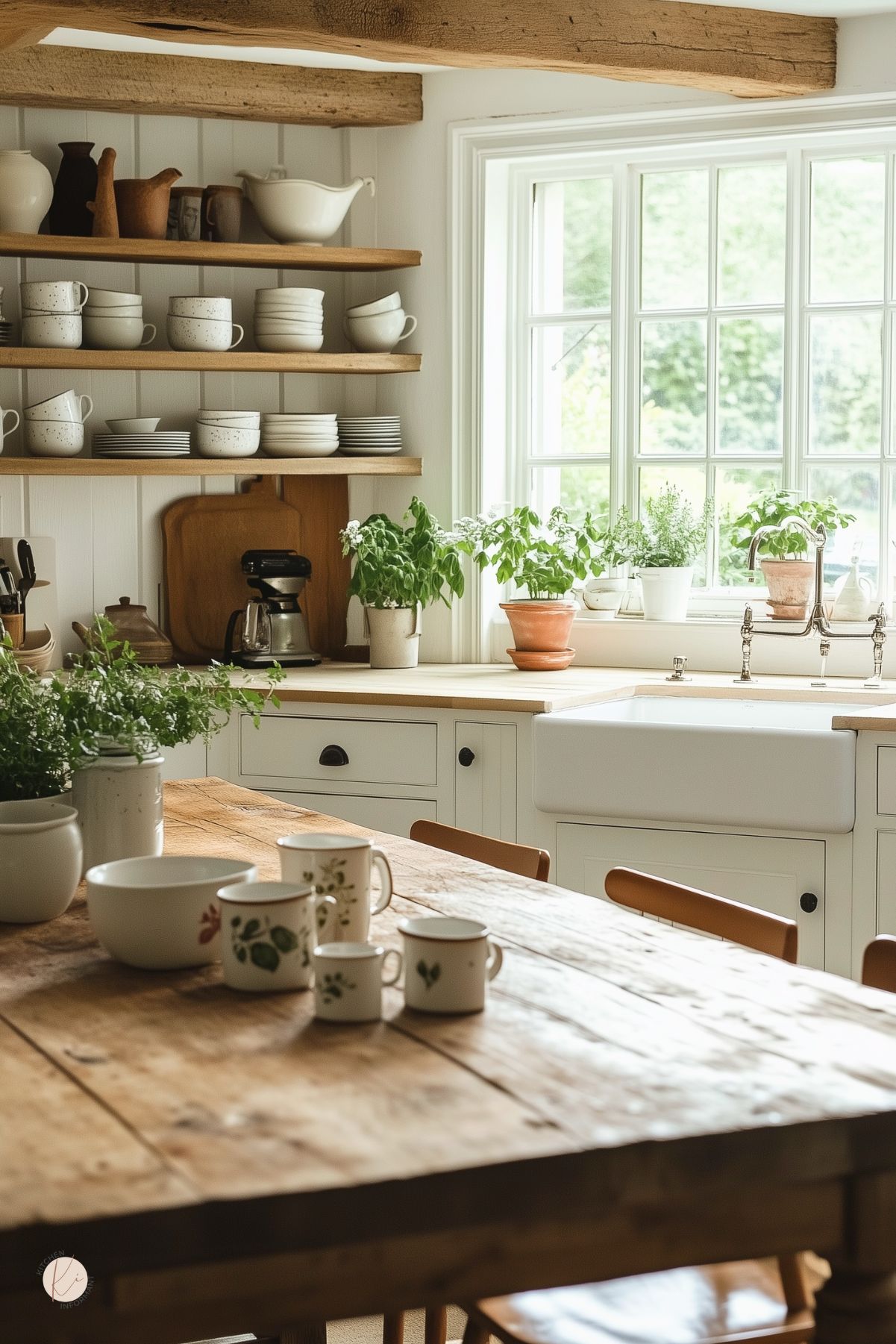The Definitive Guide to Kitchen Design Styles. Design styles for kitchens are as varied as the individuals who use them. From traditional to modern, there are many styles to choose from when it comes to designing a kitchen.
Each style has its own unique characteristics that can help create a space that is both functional and aesthetically pleasing.

Traditional design is characterized by its classic elements, such as ornate cabinetry, decorative moldings, and warm color palettes.
Modern design, on the other hand, features sleek lines, minimalism, and high-tech materials. Transitional design combines elements of both traditional and modern design to create a space that is both classic and contemporary.
Other popular design styles include country, industrial, Mediterranean, coastal, eclectic, Scandinavian, art deco, bohemian, mid-century modern, and kitschy.
Key Takeaways
- There are many different design styles for kitchens, each with its own unique characteristics.
- Traditional design is characterized by classic elements, while modern design features sleek lines and minimalism.
- Transitional design combines elements of both traditional and modern design to create a space that is both classic and contemporary.
Traditional Design
Traditional kitchen design styles are characterized by their classic, timeless appeal. They often feature ornate cabinetry, decorative molding, and a mix of textures and colors.
Traditional kitchens are perfect for those who want to create a warm, inviting atmosphere in their home.
Classic Traditional
The classic traditional kitchen design style is inspired by the elegant designs of the 18th and 19th centuries.
It features intricate details such as decorative moldings, raised panel doors, and ornate cabinetry. The color palette is typically warm and inviting, with shades of cream, beige, and brown.
Classic traditional kitchens often feature a large island with a granite or marble countertop that serves as the centerpiece of the room.
Rustic Traditional
The rustic traditional kitchen design style is inspired by the charm of country living. It features natural materials such as wood, stone, and brick.
Rustic traditional kitchens often have exposed ceiling beams, distressed cabinetry, and a warm color palette that includes shades of brown, green, and red.
The countertops are typically made of natural stone or wood, and the flooring is often made of hardwood or stone.
Overall, traditional kitchen design styles are perfect for those who want to create a warm and inviting atmosphere in their home.
Whether you prefer the elegance of classic traditional or the charm of rustic traditional, there is a design style that will suit your taste and style.
Modern Design

Modern design for kitchens is defined by sleek and clean lines, minimalism, and an emphasis on function.
This style is often associated with contemporary architecture and interior design, and it is characterized by a focus on simplicity and a lack of ornamentation.
Modern kitchens often feature high-tech appliances, hidden storage solutions, and a neutral color palette.
Contemporary Modern
Contemporary modern kitchens are characterized by their use of the latest materials and technologies.
These kitchens often feature stainless steel appliances, quartz or granite countertops, and high-end cabinetry.
The design is sleek and streamlined, with an emphasis on functionality. The color palette is usually neutral, with pops of color added through accessories or artwork.
Minimalist Modern
Minimalist modern kitchens take the clean lines and simplicity of modern design to the extreme. These kitchens often feature white or light-colored cabinetry, with little to no ornamentation.
The countertops are often made of a single material, such as concrete or quartz, and there is a focus on hidden storage solutions.
The color palette is usually limited to white, black, and gray, with occasional pops of color added through accessories. The overall effect is a kitchen that is serene and uncluttered.
Transitional Design

Transitional design is a blend of traditional and contemporary styles that creates a timeless and elegant look. This design style is characterized by a neutral color palette, simple lines, and a mix of materials.
According to Architectural Digest, transitional spaces are defined by a tonal, textural, monochromatic, and minimal aesthetic.
One of the key elements of transitional design is the use of neutral colors such as beige, gray, and white.
These colors create a calm and soothing atmosphere in the kitchen. In addition, transitional kitchens often feature a mix of materials such as wood, metal, and glass. This creates a sense of depth and texture in the space.
When it comes to the cabinetry, transitional kitchens often feature simple, clean lines with minimal ornamentation.
The hardware is usually sleek and understated, with a brushed or polished finish. Countertops are typically made of natural materials such as granite, marble, or quartz.
In terms of lighting, transitional kitchens often feature a combination of ambient, task, and accent lighting.
Pendant lights are a popular choice for task lighting over the kitchen island or sink. Under-cabinet lighting is also a great way to add task lighting in the kitchen.
Overall, transitional design is a great option for those who want a timeless and elegant kitchen that blends traditional and contemporary elements seamlessly.
Country Design

Country design style for kitchens is all about creating a warm, welcoming atmosphere that feels comfortable and inviting.
This design style is characterized by natural materials and fine craftsmanship, and it often incorporates elements of rustic charm.
There are several different types of country design styles, each with its own unique characteristics.
English Country
English country design style is inspired by the traditional cottages and manor houses of rural England.
This design style is characterized by a cozy, lived-in feel, with lots of wood and natural materials. English country kitchens often feature painted cabinetry, farmhouse sinks, and open shelving.
The color palette is typically muted, with soft greens, blues, and yellows, and floral patterns are a common decorative element.
French Provincial
French provincial design style is inspired by the rustic charm of the French countryside. This design style is characterized by elegant simplicity, with clean lines and natural materials.
French provincial kitchens often feature painted cabinetry, marble countertops, and decorative moldings.
The color palette is typically muted, with soft blues, greens, and grays, and decorative elements may include wrought iron accents and ceramic tiles.
American Farmhouse
American farmhouse design style is inspired by the traditional farmhouses of rural America. This design style is characterized by a simple, functional aesthetic, with lots of natural wood and rustic charm.
American farmhouse kitchens often feature open shelving, apron-front sinks, and butcher block countertops.
The color palette is typically muted, with whites, creams, and light blues, and decorative elements may include vintage signs, reclaimed wood, and industrial lighting fixtures.
Industrial Design

Industrial design is a popular style for kitchens that emphasizes simplicity, functionality, and a raw, unfinished look. It draws inspiration from factories and other industrial spaces, featuring materials like concrete, metal, and wood.
One of the key features of industrial design is the use of open shelving instead of cabinets, which allows for easy access to kitchenware and creates a more spacious feel. Another common element is the use of exposed pipes, ductwork, and other mechanical components as part of the decor.
To achieve an industrial look, designers often use materials like stainless steel, concrete, and reclaimed wood. These materials are often left unfinished or lightly treated to maintain a raw, natural appearance.
Industrial kitchens also often feature large, open spaces and minimalistic decor. This allows the focus to remain on the materials and functionality of the space.
Lighting is also an important aspect of industrial design, with exposed light bulbs and fixtures adding to the overall aesthetic.
Overall, industrial design is a great choice for those who want a functional and stylish kitchen with a unique, edgy look.
Mediterranean Design

Mediterranean design is inspired by the colors and textures of the Mediterranean Sea and its surrounding areas. It is characterized by warm and earthy tones, natural materials, and intricate details.
Mediterranean kitchens are known for their inviting and cozy atmosphere, which makes them a popular choice among homeowners.
Spanish Style
Spanish style is a subset of Mediterranean design that emphasizes the rustic and traditional elements of Spain.
Spanish-style kitchens often feature dark wood cabinets, exposed ceiling beams, and colorful tiles. The use of wrought iron, copper, and other metals is also common in Spanish-style kitchens.
Italian Style
Italian style is another subset of Mediterranean design that is inspired by the rustic charm of Italy.
Italian-style kitchens are known for their warm and welcoming atmosphere, which is achieved through the use of natural materials such as stone, wood, and terracotta.
Italian-style kitchens often feature open shelving, colorful tiles, and ornate details such as corbels and moldings.
Overall, Mediterranean design is a popular choice for kitchens due to its warm and inviting atmosphere, natural materials, and intricate details.
Whether you prefer the rustic charm of Spanish style or the warm and welcoming atmosphere of Italian style, there is a Mediterranean-style kitchen that is perfect for your home.
Coastal Design

Coastal design style is a popular choice for kitchens, especially for those who love the beach or ocean.
The design style is characterized by light and airy colors, natural materials, and a relaxed, laid-back vibe.
Coastal design style can be broken down into different themes, such as Nautical Theme and Tropical Theme.
Nautical Theme
Nautical theme is a subcategory of coastal design that is inspired by the sea and everything related to it.
This design style is characterized by blue and white color schemes, maritime motifs, and natural materials such as wood and rope.
Nautical theme kitchens often feature navy blue or white cabinets, brass hardware, and ship-inspired light fixtures.
A nautical theme can be incorporated into the kitchen in a subtle way by adding a few decorative elements, such as a rope-wrapped vase or a sailboat-shaped cutting board.
Tropical Theme
Tropical theme is another subcategory of coastal design that is inspired by the lush vegetation and vibrant colors of the tropics.
This design style is characterized by bright colors, bold patterns, and natural materials such as bamboo and rattan.
Tropical theme kitchens often feature bright green or yellow cabinets, colorful tile backsplashes, and woven pendant lights.
A tropical theme can be incorporated into the kitchen by adding a few decorative elements, such as a palm leaf print tablecloth or a set of pineapple-shaped salt and pepper shakers.
Overall, coastal design style is a great choice for those who want to create a relaxed and inviting atmosphere in their kitchen.
Whether you prefer a nautical or tropical theme, there are plenty of ways to incorporate coastal elements into your kitchen design.
Eclectic Design

Eclectic design is a style that combines elements from different design styles to create a unique and personalized look. It is a style that allows for creativity and individuality, and is perfect for those who want to express their personality in their kitchen design.
One of the defining features of eclectic design is the use of a variety of materials, textures, and colors. This can include anything from bold patterns and bright colors to natural materials like wood and stone.
The key is to combine these elements in a way that creates a cohesive and harmonious look.
Another important aspect of eclectic design is the use of unique and unexpected pieces. This can include anything from vintage furniture to one-of-a-kind artwork.
These pieces add character and personality to the space and help to create a space that is truly one-of-a-kind.
When it comes to designing an eclectic kitchen, there are a few key elements to keep in mind. First, it’s important to choose a color scheme that ties the space together.
This can be achieved by selecting a few key colors and using them throughout the space in different ways.
In addition to color, texture is also an important element in eclectic design. Mixing materials like wood, metal, and stone can create a rich and layered look that adds depth and interest to the space.
Eclectic design is a great choice for those who want to create a kitchen that is unique, personalized, and full of character.
By combining elements from different design styles, it is possible to create a space that is both functional and beautiful.
Scandinavian Design

Scandinavian design is known for its minimalism, functionality, and simplicity. It originated in the Nordic countries of Denmark, Finland, Iceland, Norway, and Sweden in the 1950s and has since become a popular design style for many homes and kitchens around the world.
One of the key features of Scandinavian design is the use of natural materials such as wood, stone, and leather.
This design style also emphasizes the use of light colors such as white, gray, and beige to create a bright and airy atmosphere.
In Scandinavian kitchens, you will often find clean lines and clutter-free countertops. Cabinets are typically made of wood and have a simple, streamlined design.
The use of open shelving is also common in Scandinavian kitchens, allowing for easy access to cooking utensils and dishes.
Another characteristic of Scandinavian design is the use of functional and practical furniture. In a Scandinavian kitchen, you may find a large wooden table that can be used for both cooking and dining.
This design style also emphasizes the importance of lighting, with large windows and strategically placed lamps to create a warm and inviting atmosphere.
Scandinavian design is a great choice for those who value simplicity, functionality, and natural materials.
With its clean lines, neutral colors, and practical furniture, a Scandinavian kitchen can create a cozy and inviting atmosphere for both cooking and entertaining.
Art Deco Design

Art Deco is a design style that originated in the 1920s and 1930s. It is characterized by bold geometric shapes, streamlined patterns, and a focus on modern simplicity.
In an Art Deco kitchen, one can expect to see a lot of metallic finishes, such as chrome or stainless steel, as well as high-gloss finishes on cabinets and countertops.
One of the defining features of Art Deco design is the use of bold colors. In an Art Deco kitchen, one might see rich jewel tones such as emerald green, sapphire blue, or ruby red.
These colors can be used on cabinets, walls, and even appliances to create a vibrant and eye-catching space.
Another key element of Art Deco design is the use of geometric patterns. In an Art Deco kitchen, one might see a backsplash made up of small, square tiles arranged in a herringbone pattern, or a countertop with a bold, geometric design.
These patterns can be used to add visual interest to the space and create a sense of movement.
To complete the Art Deco look, one can add accessories such as vintage-inspired light fixtures, glassware, and artwork.
These pieces can help tie the space together and create a cohesive look that is both stylish and functional.
An Art Deco kitchen is a perfect choice for those who want a space that is both modern and timeless.
With its bold colors, geometric patterns, and metallic finishes, an Art Deco kitchen is sure to make a statement and create a space that is both functional and beautiful.
Bohemian Design

Bohemian design style is characterized by bright colors, unique patterns, fun decor, and layered textures.
Boho spaces give you the freedom to make a space feel uniquely yours, with plenty of character to go around. Bohemian kitchens are no exception.
One of the key features of a bohemian kitchen is open shelving. This allows for a mix of patterns and textures to be on display, creating a comfortable and relaxed atmosphere.
Vintage accessories or appliances are also often incorporated into the design, adding to the eclectic feel of the space.
Another important aspect of bohemian design is the use of natural materials such as wood, stone, and metal.
These materials provide a sense of warmth and earthiness to the space.
Bohemian kitchens often incorporate bold colors and patterns, such as brightly colored tiles or patterned wallpaper.
These elements add to the playful and whimsical nature of the design style.
A bohemian kitchen is a comfortable and relaxed space that allows for self-expression and creativity.
It is the perfect style for those who want to break away from traditional design and create a unique space that reflects their personality.
Mid-Century Modern Design

Mid-Century Modern design originated in the mid-1940s and continued through the mid-1960s. It is characterized by clean lines, geometric shapes, and a focus on functionality.
This design style is known for its use of natural materials such as wood, stone, and metal, as well as its bold use of color.
Color Palette
Mid-Century Modern design is known for its bold use of color, particularly in the kitchen. Popular colors include bright shades of orange, yellow, green, and blue.
These colors are often used in combination with neutral tones such as white, black, and gray.
Materials
Natural materials such as wood, stone, and metal are commonly used in Mid-Century Modern kitchens.
Wood cabinets and countertops are often paired with stainless steel appliances and fixtures. Stone floors and backsplashes are also popular in this design style.
Furniture and Decor
Furniture in Mid-Century Modern kitchens is typically sleek and simple, with clean lines and geometric shapes.
Chairs and stools often feature tapered legs and curved backs. Decorative items such as vintage kitchenware, bold artwork, and patterned textiles can add personality to the space.
Overall, Mid-Century Modern design is a popular choice for kitchens due to its focus on functionality, natural materials, and bold use of color.
Kitschy
Kitschy kitchens are a design style that has been growing in popularity in recent years, especially among Gen X and baby boomers. Kitschy design is recognizable by its vintage-inspired decor, bold colors, and playful patterns.
Kitschy kitchens are all about nostalgia and whimsy, and they often incorporate vintage items like Pyrex, copper cake tins, jadeite, and depression glass.
One key aspect of kitschy design is the use of retro-inspired patterns like polka dots, checkerboards, and geometric shapes.
These patterns can be incorporated into kitchen curtains, tablecloths, or even backsplash tiles. Mixing and matching patterns is encouraged, as it adds to the playful and eclectic vibe of the space.
Another hallmark of kitschy kitchens is the use of bold colors. Bright reds, yellows, and blues are common, as are pastel pinks and greens.
These colors can be incorporated into the walls, cabinets, and even appliances. Kitschy kitchens often feature open shelving, which allows for easy access to colorful dishes and glassware.
Kitschy kitchens are a fun and playful design style that can add a touch of nostalgia to any home. By incorporating vintage items, bold colors, and retro-inspired patterns, homeowners can create a space that is both functional and whimsical.





